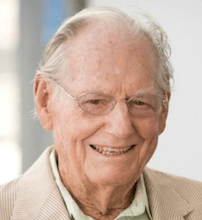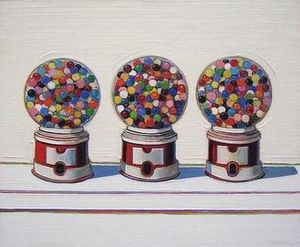Wayne Thiebaud facts for kids
Quick facts for kids
Wayne Thiebaud
|
|
|---|---|
 |
|
| Born |
Morton Wayne Thiebaud
November 15, 1920 Mesa, Arizona, U.S.
|
| Died | December 25, 2021 (aged 101) Sacramento, California, U.S.
|
| Nationality | American |
| Education | Sacramento State College San Jose State College Sacramento State |
| Known for | Painting, Printmaking |
| Movement | Pop Art, New Realism, Bay Area Figurative Movement |
| Awards | National Medal of Arts (1994) |
Morton Wayne Thiebaud (pronounced TEE-boh) was an American painter. He was born on November 15, 1920, and lived to be 101 years old, passing away on December 25, 2021. Thiebaud was famous for his bright, colorful paintings of everyday things. Imagine pies, lipsticks, paint cans, ice cream cones, pastries, and hot dogs! He also painted amazing landscapes and people.
Thiebaud is often linked to the Pop art movement. This is because he was interested in objects from mass culture. However, his early works were created just before the main Pop Art artists became famous. Thiebaud used thick paint and very bright colors in his art. He often included clear, sharp shadows, like those you see in advertisements.
Contents
Wayne Thiebaud's Early Life and School
Wayne Thiebaud was born in Mesa, Arizona. A year later, his family moved to Southern California. He spent most of his childhood there and finished high school in Long Beach, California. His family belonged to The Church of Jesus Christ of Latter-day Saints. His father worked many jobs, including a mechanic for Ford Motor Company.
One summer when he was in high school, Wayne had an amazing chance. He worked at Walt Disney Studios! He helped draw the "in-between" frames for characters like Goofy, Pinocchio, and Jiminy Cricket. The next summer, he studied at the Frank Wiggins Trade School. From 1938 to 1949, he worked as a cartoonist and designer. He even served as an artist in the First Motion Picture Unit of the United States Army Air Forces from 1942 to 1945.
In 1949, he started college at San Jose State College (now San José State University). He then moved to Sacramento State College (now California State University, Sacramento). There, he earned his bachelor's degree in 1951 and his master's degree in 1952.
Wayne Thiebaud's Painting Career
After college, Thiebaud began teaching at Sacramento City College. In 1960, he became an assistant professor at the University of California, Davis. He taught there until 1991 and inspired many art students. He was a Professor Emeritus (a retired professor who keeps their title) there until he passed away. Thiebaud believed in hard work and loved realism in art.
In 1956–57, he took a break and spent time in New York City. There, he became friends with famous artists like Elaine de Kooning, Willem de Kooning, and Franz Kline. He was also influenced by artists like Robert Rauschenberg and Jasper Johns. During this time, he started painting small pictures of food seen in windows. He focused on their simple shapes.
When he returned to California, he continued this style. He focused on basic shapes like triangles, circles, and squares. He also helped start art cooperatives, which are groups of artists working together.
In 1960, Thiebaud had his first solo art show in San Francisco at the San Francisco Museum of Modern Art. He also had shows in New York City. These shows didn't get much attention at first. But two years later, in 1962, a show at the Sidney Janis Gallery in New York officially launched Pop art. This show brought Thiebaud national recognition. Even though his art was shown with Pop Art, he always said he was just a painter of "illusionistic form."
In 1961, Thiebaud met art dealer Allan Stone. Stone gave him his first big chance. Stone was Thiebaud's art dealer until Stone's death in 2006. After Stone passed away, Thiebaud's son, Paul Thiebaud, took over as his dealer. Paul was also a successful art dealer, but he sadly passed away in 2010.
In 1962, Thiebaud's art was part of a very important exhibition. It was called "New Painting of Common Objects" at the Pasadena Art Museum. This show is considered one of the first Pop art exhibitions in the United States. These artists were part of a new movement that surprised the art world.
In 1963, he started painting more people. These figures often looked stiff, with every detail sharply shown. In 1964, he began making prints and continued to do so throughout his career.
Wayne Thiebaud's Personal Life
Wayne Thiebaud was married twice. With his first wife, Patricia Patterson, he had two children. One of his children is the writer and model Twinka Thiebaud. With his second wife, Betty Jean Carr, he had a son named Paul LeBaron Thiebaud, who became an art dealer. He also adopted Betty's son, Matthew.
Thiebaud passed away at his home in Sacramento, California on December 25, 2021. He was 101 years old.
Wayne Thiebaud's Artworks

Thiebaud is famous for his paintings of everyday items found in diners and cafeterias. Think of pies and pastries! When he was young, he worked at a cafe called Mile High and Red Hot. "Mile High" was ice cream and "Red Hot" was a hot dog.
He was connected to the Pop art movement because he painted things from mass culture. However, his works were created before the main Pop Art artists. This suggests Thiebaud might have influenced the movement. He used thick paint and bright colors. He also included clear shadows, like those in advertisements. Thiebaud didn't like labels like "fine art" or "commercial art." He called himself "just an old-fashioned painter." He didn't like Andy Warhol's "flat" paintings and didn't see himself as a Pop artist.
Besides pastries, Thiebaud also painted characters like Mickey Mouse. He painted landscapes, street scenes, and cityscapes too. These were influenced by the artist Richard Diebenkorn. His paintings like Sunset Streets (1985) and Flatland River (1997) look very realistic. They have been compared to the work of Edward Hopper, another artist who loved painting everyday American life.
Famous Paintings by Thiebaud
- 1961 Drink Syrups
- 1961 Pies, Pies, Pies
- 1962 Around the Cake
- 1962 Bakery Counter
- 1962 Confections
- 1962 Candy Machine
- 1963 Display Cakes
- 1963 Cakes
- 1963 Girl with Ice Cream Cone
- 1964 Three Strawberry Shakes
- 1964 Eight Lipsticks
- 1964 Man Sitting - Back View
- 1964 Lemon Cake
- 1966 Powder With Puff
- 1968 Coloma Ridge
- 1970 Seven Suckers
- 1971 Four Cupcakes
- 1975 Shoe Rows
- 1976 Potrero Hill
- 1977 24th Street Intersection
- 1981 Hill Street (Day City)
- 1987 Two Paint Cans
- 1991 The Three Cows
- 1992 Thirteen Books
- 1993 Apartment View
- 1993 Coastline
- 1996 Farm Channel
- 1999 Reservoir
- 2000 Clown Cones
- 2002 Jolly Cones (Ice Cream Cones)
- 2008 Three Ice cream Cones
- 2010 The Google 12th Birthday Cake
- 2010 Tulip Sundae
Art Collections and Exhibitions
Thiebaud's art can be seen in many museums. These include the Los Angeles County Museum of Art, the Crocker Art Museum, and the Whitney Museum of American Art. Other museums like the Hirshhorn Museum and Sculpture Garden and the San Francisco Museum of Modern Art have also shown his work.
Some special exhibitions of Thiebaud's art include:
- A big show in 2001 at the Whitney Museum.
- A show in 2012 at Acquavella Galleries.
- A show in 2021 at the Toledo Museum of Art.
The Crocker Art Museum has hosted a Thiebaud exhibition every ten years since 1951. They even had "Wayne Thiebaud 100" in 2020 to celebrate his 100th birthday!
Awards and Recognition
Wayne Thiebaud received many awards for his art:
- In 1987, he won the Golden Plate Award from the American Academy of Achievement.
- On October 14, 1994, President Bill Clinton gave him the National Medal of Arts. This is a very high honor for artists in the U.S.
- In 2009, he received the Artistic License Award from California Lawyers for the Arts.
- He also got the Lifetime Achievement Award for Art from the American Academy of Design in 2001.
- In 2010, Thiebaud was added to the California Hall of Fame at The California Museum.
- In 2013, he received the California Art Award. This was for helping to make California art famous around the world.
Art Auction Records
Wayne Thiebaud's paintings have sold for very high prices at auctions.
- In November 2019, his 2011 painting Encased Cakes sold for $8.46 million at Sotheby's. This set a new record for his art at the time.
- This record was broken in July 2020. His 1962 painting Four Pinball Machines sold for an amazing $19,135,000 at Christie's in New York City!
Artists Influenced by Thiebaud
Wayne Thiebaud was a great teacher and influenced many other artists.
- One of his students from Sacramento City College was Fritz Scholder. Scholder became very important in American Indian art.
- The painter Mel Ramos considered Thiebaud his mentor.
- Other artists he taught include Faith Bromberg, Vonn Cummings Sumner, and Christopher Brown.
Sharon Core is a photographer who creates photos that look just like Thiebaud's paintings.

